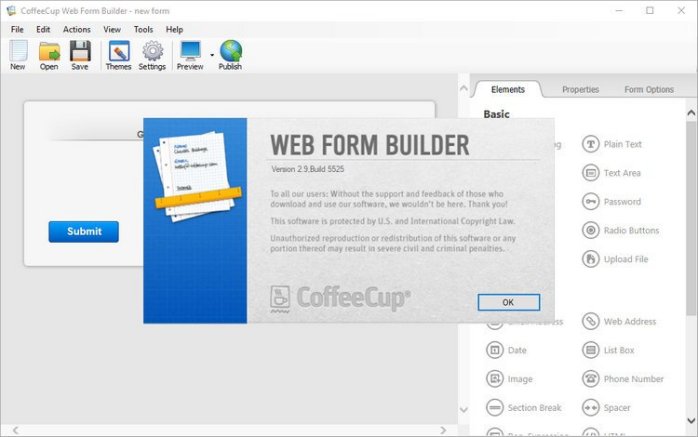

The reaction chamber is a strong vessel that can withstand the intense pressure of heated gases with exploding. Having little to nothing to do with bombs of the military variety, a bomb calorimeter includes a reaction chamber where the reaction (usually a combustion reaction) takes place. Chemists often use a device known as a bomb calorimeter to measure the heat exchanges associated with chemical reactions, especially combustion reactions. For situations in which exactness and accuracy is at stake, a more expensive calorimeter is needed.
#Coffeecup web form builder manual professional#
But at the professional level, a cheap Styrofoam cup and a thermometer isn't going to assist a commercial food manufacturer in determining the Calorie content of their products. The coffee cup calorimeters used in high school science labs provides students with a worthwhile exercise in calorimetry. And any design of a calorimeter experiment must give attention to reducing the exchanges of heat between the calorimeter contents and the surroundings. Any error analysis of a calorimetry experiment must take into consideration the flow of heat from system to calorimeter to other parts of the surroundings. The more that these other heat exchanges are reduced, the more true that the above mathematical equation will be. The value of a lid on the coffee cup is that it also reduces the amount of heat exchange between the water and the surrounding air. The role of the Styrofoam in a coffee cup calorimeter is that it reduces the amount of heat exchange between the water in the coffee cup and the surrounding air. Q ice = - Q surroundings = -Q calorimeter This statement could be placed in equation form as

It is assumed that there is a heat exchange between the iceand the water in the cup and that no other objects are involved in the heat exchanged. So if an attempt is being made to determine the specific heat of fusion of ice using a coffee cup calorimeter, then the assumption is that the energy gained by the ice when melting is equal to the energy lost by the surrounding water. The assumption behind the science of calorimetry is that the energy gained or lost by the water is equal to the energy lost or gained by the object under study.

So if the mass of water and the temperature change of the water in the coffee cup calorimeter can be measured, the quantity of energy gained or lost by the water can be calculated. And in fact, the quantity of energy gained or lost is given by the equation So how can such simple equipment be used to measure the quantity of heat gained or lost by a system? We have learned on the previous page, that water will change its temperature when it gains or loses energy. The more sophisticated cases include a lid on the cup with an inserted thermometer and maybe even a stirrer. It is a coffee cup calorimeter - usually filled with water. Rather, it is because the calorimeter used in high school science labs is more commonly referred to as a Styrofoam cup. Fear not the reason for the lack of memory is not a sign of early Alzheimer's. Most students likely do not remember using such a fancy piece of equipment known as a calorimeter. A calorimeter is a device used to measure the quantity of heat transferred to or from an object. These types of labs are rather popular because the equipment is relatively inexpensive and the measurements are usually straightforward. In physics class (and for some, in chemistry class), calorimetry labs are frequently performed in order to determine the heat of reaction or the heat of fusion or the heat of dissolution or even the specific heat capacity of a metal. Now that sounds very textbooky but in this last part of Lesson 2, we are going to try to make some meaning of this definition of calorimetry. Calorimetry is the science associated with determining the changes in energy of a system by measuring the heat exchanged with the surroundings.


 0 kommentar(er)
0 kommentar(er)
